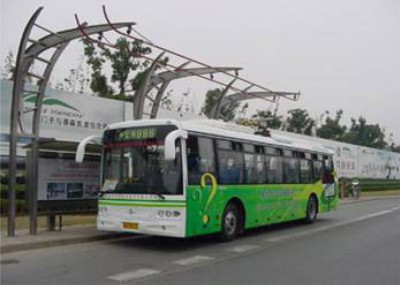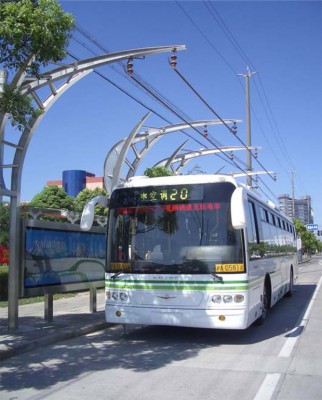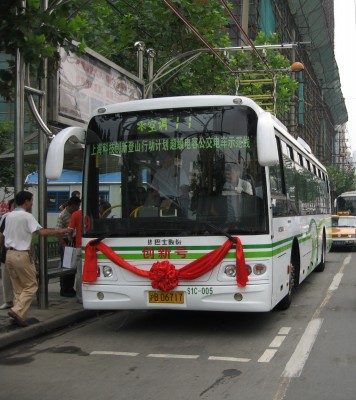Sinautec’s forty-one seat Ultracap Buses have been serving the Greater Shanghai area since 2006. The bus is powered entirely by electricity, which is stored in ultracapacitors and batteries onboard. When the bus stops at passenger stops, the overhead charger quickly recharges the ultracapacitor onboard to allow the bus to go to its next destination. The vehicle is noise free and generates no tailpipe pollution.
The Ultracapacitor
Like batteries, ultracapacitors are energy storage devices. However, batteries store electricity chemically, whereas ultracapacitors store them electrostatically between two opposite charged plates. An ultracapacitor can release energy much faster (20x) and with more power than a battery that relies on slow chemical reactions. Ultracapacitors can be used for over a quarter million recharging cycles. In comparison, lithium ion batteries have less than two thousand cycle life span. The longer life cycle translates into low maintenance costs for ultracapacitor devices. The amount of energy an ultracapacitor can hold is proportional to the surface area of the ultracapacitor. Several nano-scale technologies hold the promise of increasing the amount of electricity that can be stored in an ultracapacitors by drastically increasing the surface area of the ultracapacitor. The current worldwide ultracapacitor market is estimated to be over $400 million, and has experienced double-digit growth rate in the past five years.
Extended Range
The Ultracap Bus has a short range of between 3.5 and 5.5 miles (depends on air conditioning usage). This is enough energy for the vehicle to travel between bus stops and charge the ultracapacitor until the next bus stop. The Ultracap Hybrid Bus has also batteries which serve as a back up power and allow the bus to extend its traveling range. The Ultracap Hybrid Bus has a top speed of 33 miles per hour and has a maximum range of 45 miles between charges. The bus is ideal for on-campus shuttles and municipal bus lines with short in-between-stop intervals.
No Emmisions
After over one million miles of operation, the ultracapacitor buses have resulted in savings of over 200,000 gallons of diesel fuel and 2,000 tons of carbon dioxide emissions. Replacing a single diesel bus with an ultracapacitor bus would result in the following savings each year:
- An average of 9,500 gallons of diesel fuel
- $20,000 in annual fuel cost savings
- 50 tons of carbon dioxide emission
- 3 tons of nitrogen oxide emission
- 50 kilograms of particulate matter emission
Adopting the ultracapacitor bus can lower the long term healthcare costs of the area by reducing nitro-oxide and particulate matter related illnesses, such as asthma and lung cancer. Another advantage is that the ultracapacitor bus can contribute to the reduction of urban noise pollution. Taken into consideration the lifetime fuel savings, the ultracapacitor buses are cost competitive compare to conventional diesel buses.
Solar Option
Solar panels can be placed on top of ultracapacitor bus stations, serving both as a shelter and to convert sunlight into electricity. If powered by renewable electricity, the ultracapacitor bus could operate with a zero carbon footprint. When solar panels are placed on top of charging stations and surrounding buildings, Sinautec’s Ultracapacitor Bus can be powered completely by the sun. The bus draws electric power from the charging station solar panels on sunny days, and from the electric grid in cloudy conditions. The Ultracap Bus uses less than 10% the fuel cost of a conventional bus. Compared to a diesel engine bus, an Ultracap Bus can achieve a lifetime fuel saving of $200,000. The vehicle is noise free and generates no tailpipe pollution. The ultracapacitor bus, when used in conjunction with renewable energy electricity production, would be a zero carbon transportation solution to mass public transportation. The solar option will increase the cost of the ultracapacitor bus line by approximately 20%.

The ultracap bus is charging at the bus stop
Ultracap Bus
Ideal for on-campus shuttle and municipal bus lines with short in-between-stop intervals. Sinautec’s Ultracap Bus offers the advantage of low fuel cost, low noise pollution, and zero tailpipe emission.
| Length | 37 Feet 6 Inches |
|---|---|
| Width | 8 Feet 2 Inches |
| Height | 11 Feet 1 Inch |
| Passengers | 41 |
| Maximum Speed | 30 MPH |
| Power Source | 5.9 KWH Ultracapacitors |
| Electric Usage | 1.5 KWH per Mile |
| Recharging Time | 5-10 Minutes* |
| Maximum Range | 3.5 Miles (with full air conditioning ) 5.5 Miles (without air conditioning) |
| Bus Weight | 12.5 Tons |
| Acceleration | 4 Feet / Second |
| Maximum Slope | 12 Degrees |
| Voltage & Current | 600-720V, 200A |
| Air Conditioning | 15 KW Air Conditioning |
| Vehicle Life | 8-12 Years |
Ultracap Hybrid Bus
Ideal for on-campus shuttle or urban municipal bus lines. Compare to the Ultracap Bus, Ultracap-Battery Hybrid Bus offers the advantage of extended range.
| Length | 37 Feet 6 Inches |
|---|---|
| Width | 8 Feet 2 Inches |
| Height | 11 Feet 1 Inch |
| Passengers | 41 |
| Maximum Speed | 33 MPH |
| Power Source | 2.25 KWH Ultracapacitors** 60 KWH Lead Acid Batteries*** |
| Electric Usage | 1.5 KWH per Mile |
| Recharging Time | 5-10 Minutes for Ultracapacitors* 6 hours for Lead Acid Batteries |
| Maximum Range | 45 Miles (with full air conditioning) |
| Bus Weight | 12.5 Tons |
| Acceleration | 4 Feet / Second |
| Maximum Slope | 12 Degrees |
| Voltage & Current | 600-720V, 200A |
| Air Conditioning | 11,6 KW Air Conditioning |
| Vehicle Life | 8-12 Years Battery Replacement Every 18 Months |
** Lead Acid Battery-Ultracapacitor ratio can be customized to fit client’s needs
*** Other Forms of Batteries available
Video
Sinautec Ultracapacitor Bus







